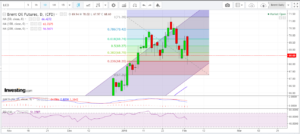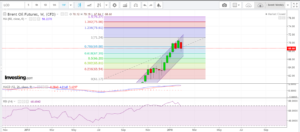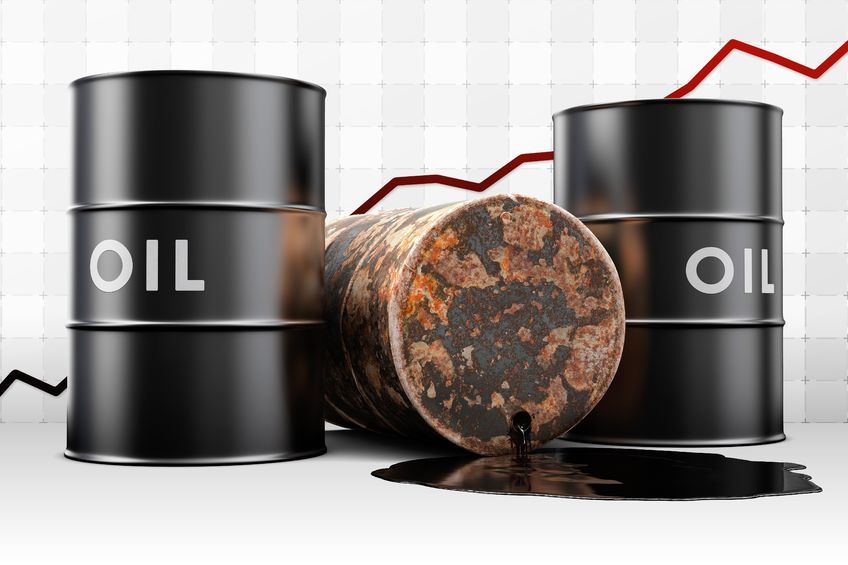Crude Oil
Oil prices finished lower on Friday to tally a loss for the week, as traders weighed a steady increase in U.S. output against OPEC’s ongoing efforts to drain the market of excess supplies. Brent crude futures gave up $ 1.04 to settle at $ 68.58 /bbl. WTI eased by 35 cents to close at $65.55 /bbl.
The deep decline in Brent narrowed the gap between it and WTI to its narrowest since August; that wide gap has boosted U.S. exports in recent months. This also reflects the return of Forties supply to normalcy.
The fall was also aided by strong US job numbers which strengthened the US Dollar. Brent touched a low of $ 67.96 /bbl before the underlying bullishness bolstered prices at a key technical support.
U.S. jobs growth surged in January and wages rose, recording their largest annual gain in more than 8-1/2 years. The once-strong connection, where oil rises when the dollar falls and vice versa, ebbed between 2014 and 2016 during a three-year supply glut. With supply tightening, the relationship has reasserted itself. Since the beginning of the year, oil and the U.S. dollar index have had a correlation of -0.86, with -1 being a perfectly inverse relationship.
For the week, WTI crude lost roughly 1%, while Brent declined about 2.8%.
The number of oil drilling rigs climbed for a second week in a row as per the Baker Hughes weekly report. At the end of last week, the count had risen to 765, implying that further gains in domestic production are ahead.
Money managers cut their net bullish bets in ICE Brent by 6,500 lots last week, the biggest weekly decline since last November. WTI futures and options also saw a net reduction of 18,000 lots by the group, mainly due to liquidation in length. The two benchmarks combined are down 25,000 lots last week, but total net lengths, at 1.11 million lots, are still near their record high levels.
Technical Analysis


The daily charts show a bearish engulfing candle which is an overwhelmingly bearish indicator. While the Daily RSI has plunged into neutral territory, in the weekly charts the RSI still looks to be firmly in bullish territory.
On the other hand, prices bounced strongly off the $ 68.00 support that we had mentioned last week.
Our view is that the uptrend is still intact and we may be in for a long period of consolidation. While we would not recommend fresh longs, we would advise holding current longs with a stop below $ 67.70. Further supports lie at $ 67.30 -40 and then in the $ 66.20- 30 area. Resistances lie at $ 68.80 and then $ 69.30 above.
Naphtha
Naphtha markets continue to remain under pressure with the demand supply balance clearly skewed towards excess supply. Going forward, a pick-up in gasoline demand may help support naphtha as it is used as a blending component with gasoline but for now the near term sentiments are weak.
The balance February paper naphtha crack has once again slipped into negative and is valued at -$ 0.10 /bbl today.
Gasoline
Sentiments for the gasoline market as a whole are turning slightly bullish with margins expected to stay supported going into spring as several refineries, including Bayernoil in Germany, Lavera and Stanlow are planning spring maintenance turnarounds. This is in addition to the upcoming heavy turnarounds in Asia and the Middle East.
For today however, the balance February paper 92 Ron gasoline crack has fallen to $ 12.55 /bbl.
Hedging recommendation made earlier are being retained (until they are squared off). Current values are juxtaposed in (Red)
March 2018 $ 13.35 / bbl (12.95 currently).
Distillates
Jet fuel continues to dominate the Asian middle distillate story as prompt supply lags behind strong demand for the fuel. The ongoing cold wave particularly in Japan and South Korea which extensively use kerosene as a heating fuel is propping up the market as evidenced by the Jet-Dubai crack which rose above $ 16 /bbl in late January, the highest seasonal value since 2015.
The balance February paper gasoil crack is slightly lower at $ 15.35 /bbl. The 10 ppm crack is at $ 16.20 /bbl. The February regrade continues to post gains and is valued at $ 1.40 /bbl today.
Hedging recommendations made earlier are being retained (until they are squared off). Current values are juxtaposed in (Red)
February 2018 Gasoil 10 ppm $ 16.15/bbl (16.20) : Jet $ 15.50/bbl (16.75) (add more at $ 16.75 / bbl and $ 16.00 / bbl)
4Q 2018 Gasoil 500 ppm $ 15.35 /bbl (14.95): Gasoil 10 ppm $ 16.20 /bbl (15.95): Jet $ 16.00 /bbl (15.85).
1Q 2019 Gasoil 500 ppm $ 15.85 /bbl (15.30) : Gasoil 10 ppm $ 16.80 /bbl (16.25): Jet $ 16.55 /bbl (16.10)
We would also recommend hedging Cal 2019 (for aggressive hedgers) at
Cal 2019 Gasoil 500 ppm $ 16.10 /bbl (16.10): Gasoil 10 ppm $ 17.45 /bbl (17.05): Jet $ 16.85 /bbl (16.90)
Fuel Oil
Limited buying interest for physical cargoes, adequate supplies and expectations of high volumes arriving into Asia from the West are collectively keeping fuel oil prices under pressure.
The February 180 cst crack is however valued higher at -$ 5.30 /bbl. The visco spread is slightly lower at $ 0.80 / bbl.
About this blog
This blog post attempts to give a top level summary of the Singapore market goings on to a person who seeks to obtain a directional sense of the market on a daily basis.
Disclaimer : All the views are the author’s personal views. These do not constitute an advice to buy or sell any commodity
